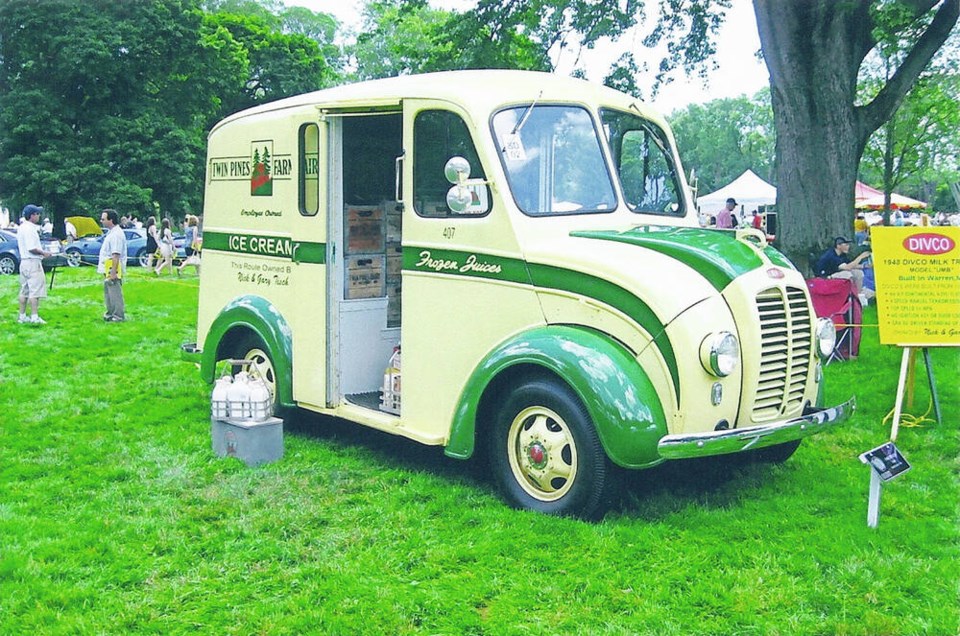For the decades before convenience stores, jug milk outlets and easy travel, milk was delivered daily to urban homes. Bread and other products were delivered too, but milk was the most popular before refrigeration became common.
While clinking milk bottles and clip-clopping horses at five in the morning weren’t always welcome, the convenience of fresh milk delivered to the door made up for it. Before homogenization, cold weather froze the cream at the top of the bottle making it rise at funny angles
As noted, early milk wagons were drawn by horses and it was a valuable Dobbin that learned to plod along at just the right pace, pausing when necessary while its master completed deliveries. As motor vehicles became popular, especially after the Second World War, motorized delivery gradually replaced those faithful four legged partners.
One of the early and most popular delivery trucks was the Divco created by Detroit-based Detroit Electric Car Co., maker of the Detroit Electric car. By the 1920s sales of electric cars had virtually finished so the company decided to develop an electric milk wagon. Testing showed it was too heavy and its driving range too limited, but Detroit’s management concluded that motorized delivery still had potential.
To pursue this, Detroit Electric Car Co. formed Detroit Industrial Vehicle Co. — hence Divco — and designed a prototype engine-powered milk truck. Motorized delivery proved faster than horse-drawn so in 1926 Divco built 25 Model A Divco evaluation vehicles. This led to the production the Model B Divco in 1927 with a four cylinder Continental engine. Although engine-powered, the Model B’s square wooden body still resembled a horse-drawn milk wagon without the horse.
The Model B could be driven from the left or right running board or from the front seat, and its patented “Divco Safety Brake” automatically locked when the driver was out. Model Bs and the short-lived Model C were joined by the Model G whose hood and separate fenders made it look less like a milk wagon and more like a conventional truck.
A major improvement came in 1931 when the Divco Model H was introduced with a clever dropped frame design that allowed the deliverer to drive while standing or sitting, and easily move back and forth to enter and leave from either side. It was still necessary, however, to step over the central driveshaft which ran at its former height.
In spite of its popular drop-frame design Divco suffered badly with the onset the Depression in 1929. By 1931 it was being operated by a credit committee, and in 1932 was sold to its engine supplier Continental Motors Corp. who changed the name to Continental-Divco Co.
The Depression continued to depress sales, and in spite of a revised and larger six-cylinder Model K, followed by Models M, Q and R, Divco was still suffering. It finally showed a profit in 1935 thanks to the more economical Model S.
Alas parent company Continental’s financial problems forced it to sell Divco to bus and truck manufacturer Twin Coach Co. Renamed the Divco-Twin Truck Co., it built the Divco Model S and a Twin Coach delivery truck that resembled a small bus.
The best remembered Divco was the Model U introduced in 1938. The old milk wagon-influenced lines were completely gone, replaced by a rounded, streamlined all-steel body with integrated headlamps and slanted windshield. A year later came the Model UB aimed at bakeries. The U was renamed the UM (for milk) and a longer model UL for uses such as laundries, dry cleaners and parcel delivery.
Divco prospered with the Model U’s and in 1939 production moved from the 53,000 square foot Detroit factory to a larger 136,000 square foot plant in Warren, Michigan. During the Second World War Divco produced aircraft parts, before being able to return to truck production in 1944.
Despite competition from the Big Three (General Motors, Ford and Chrysler), White Motor Co. and the Pak-Age-Car built by Stutz and later by Auburn, Divco Corp. still emerged as the light delivery vehicle leader.
The immediate post-war years were Divco’s best. Pent-up demand for delivery trucks and high consumption of mostly home delivered milk brought production of 6,385 trucks in 1948. From there it was gradually downhill as milk delivery waned due to more women working outside the home, universal refrigeration and lower cost supermarket milk. This decline brought Divco’s merger with bus maker Wayne in 1956.
Despite several models and engines, Divco was sold to Highway Products Corp. in Ohio in 1966. Divco production continued in declining numbers under different ownerships before finally landing with Correct Manufacturing Co. in Delaware. Divco build its last three vehicles in 1986, a victim of changing lifestyles and declining home delivery.



